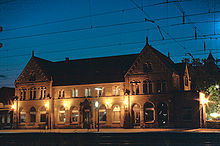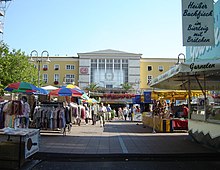Frankfurt-Bebra Railway
The Frankfurt-Bebraer Railway (also called Bebraer Bahn or Bebra-Hanauer Bahn ) was an initially Kurhessian , later a Prussian railway project. It comprises the Bebra – Fulda railway , the Hessian Kinzigtal Railway and the Hanau – Frankfurt (southern Main ) railway .
prehistory
The contours of the state of Kurhessen were shaped by the center in Niederhessen with the capital Kassel , to which the Grand Duchy of Fulda joined in the southeast as a province and then, further to the southwest, the hose-like province of Hanau , which enclosed the Free City of Frankfurt in the north. Hanau was the second largest city in the Electorate. The country was, however, characterized by low mountain ranges that could not yet be overcome with the railway technology that was available in the first half of the 19th century . For this reason, Kassel and Frankfurt were initially connected by the Main-Weser Railway , which crossed the Upper Hesse province of the Grand Duchy of Hesse and, as a condom line, belonged to the three neighboring states. Hanau received its own connection to Frankfurt through the private Frankfurt-Hanauer Eisenbahn-Gesellschaft and - connected with a change there - indirectly also to its state capital, Kassel.
With the advancement of railway technology, more than 10 years later it seemed possible to think of a connection from Kassel to Hanau via Fulda , which ran almost exclusively on the Kurhessian area and was to be operated by its state railway. After the Kurhessische estates assembly had passed a corresponding law, the connection could be established since 1863.
construction

With the Friedrich-Wilhelms-Nordbahn, Bebra already had a railway connection to Kassel. From there, the route was driven south with the destination Hanau. For the Electoral Hesse and the beginning of the Prussian period, the name was initially Bebra-Hanau Railway . In order not to leave the Hessian state territory, the railway followed the Haune valley , not that of the Fulda , which belonged to the Grand Duchy of Hesse . A winding route was accepted for this. The first section between Bebra and Hersfeld was opened on January 22, 1866.
After the annexation of the electoral state by Prussia due to the Austro-Prussian War in 1866, the project was taken over by Prussia and construction began in the southern section. The Kingdom of Prussia was able to open the line within two years, with the trains between Hanau and Frankfurt initially being carried over the Frankfurt – Hanau railway line and the Frankfurt connecting line to Frankfurt's western railway stations . The Main Bridge at Hanau-Steinheim was not completed until 1873 , which made it possible for the trains to enter the Frankfurt Main-Neckar station via Offenbach am Main , Frankfurt Bebraer Bahnhof and the Main-Neckar-Brücke . Due to the compulsory point given by crossing the Main , a new, large station had to be built for Hanau at the point where the Frankfurt-Bebraer Bahn crossed the continued route of the Frankfurt-Hanauer Eisenbahn-Gesellschaft on its way to Aschaffenburg ( Hanau Ost ; later renamed to Hanau Hauptbahnhof ).
| January 22, 1866 | Bebra - Bad Hersfeld |
|---|---|
| October 1, 1866 | Bad Hersfeld - Hünfeld - Fulda |
| May 1, 1867 | Hanau (East) - Wächtersbach |
| July 1, 1868 | Fulda - Neuhof |
| July 1, 1868 | Wächtersbach– Steinau (street) |
| December 15, 1868 | Neuhof – Steinau (street) (including the hairpin in Elm station ) |
| November 15, 1873 | Hanau (East) - Frankfurt Bebraer train station |
| December 1, 1875 | Frankfurt Bebraer Bahnhof– Frankfurt Main-Neckar-Bahnhof |
In 1874 the new line was placed under the Royal Direction of the Bebra-Hanau Railway , which was relocated from Kassel to Frankfurt and was called the Royal Railway Direction to Frankfurt am Main from April 1, 1874 . On November 15, 1874, the name Bebra-Hanauer Eisenbahn was replaced by Frankfurt-Bebraer Eisenbahn .
course
The route runs from Frankfurt to Hanau south and parallel to the Main , then on the northern slope of the Kinzig valley , crosses the ridge and leads from there to Fulda.
The regional traffic volume in the sparsely populated region north of Fulda was low. The branching branch lines changed little about that. The Knüllwaldbahn began in Bad Hersfeld in 1906 , and a remainder of it is still used in freight traffic. The Hersfeld circular path branched off there from 1912 to 1993 . In Hünfeld there was a connection via Eiterfeld to Vacha , from Götzenhof you could drive from 1889 to 1986 through the northern Rhön to Hilders .
In 1914, a connecting curve south of Bebra was opened, which enables journeys from Frankfurt to Leipzig / Berlin without stopping in Bebra, but also without changing the direction of travel, hence the common name "Berlin curve".
Changes
Initially, in 1888, the Frankfurt West Train Stations were replaced by the main train station as the end point of the route.
The topographical problem area was overcoming the ridge between Flieden and Schlüchtern . With the technical means available at the time of construction of the railway, a tunnel almost 4 km long was initially too complex and expensive. Instead, a switchback was set up, with Elm station as the switchback station. Here all through trains had to change the direction of travel, which became increasingly unreasonable with the increasing volume of traffic and the connection of the Fulda-Main Railway in Elm in 1873. The technology for building longer tunnels was considerably improved at the beginning of the 20th century, particularly due to the dynamite that was now available . In 1909, the construction of the Schlüchtern tunnel under the thistle lawn, which was completed on February 14, 1914 and went into operation on May 1, began. This tunnel was supplemented by a second tube that was released in 2011.
In World War II the strategically important route goal from the air raids of the Allies , for that. B. on December 4, 1944 at Schlüchtern and Gelnhausen .
In 1963 electrification was completed.
In its southern section, the Südmainische S-Bahn was built parallel between Offenbach Ost and Hanau Hbf . This route is nevertheless an independent infrastructure. Between Offenbach Ost and the Hanau main train station, there is no possibility of crossing with the Frankfurt-Bebraer railway, despite the close proximity.
business
Importance and sections
Since it was built, the traffic importance of the route has changed several times. Until the Second World War it was mainly used for traffic on the Frankfurt – Leipzig route. Due to the division of Germany , this east-west traffic came to a standstill - apart from the transit and interzonal trains , which now ran in Bebra with a change of locomotive and direction. As a result, the main direction of traffic shifted to north-south, from Hanover and Hamburg to Frankfurt and also via the Fulda-Main Railway towards Bavaria. As a result, the historical connection was now operationally divided into two parts:
- the Hanau – Frankfurt line on the south bank of the Main
- the Kinzig Valley Railway between Hanau and Fulda
- the Bebra – Fulda railway line , connected to the Flieden – Gemünden railway line ( Fulda-Main Railway ) via the Kinzig Valley Railway to Flieden
Incidents
- On November 14, 1884, in the northeast entrance of the Hanau Ost train station (today: Hanau Hauptbahnhof ), a passenger train drove onto a freight train and a third train crashed into the rubble. 22 people died.
- On November 8, 1900, a passenger train drove onto the Berlin-Frankfurt express train between the Mühlheim am Main and Offenbach am Main stations . 12 people died, 4 were also injured.
- In 1929 the long-distance express train Basel-Berlin derailed in Kerzell station , whereby the leading steam locomotive 01 005 overturned. A traveler was seriously injured.
- On April 27, 1954, a local train, the Scandinavian Express , drove into the flank when it entered Hanau Central Station. Four people died and 97 others were injured.
- On April 13, 2012, east of the Mühlheim (Main) –Dietesheim S-Bahn station - here the S-Bahn line runs on a single track parallel to the main line - an RB collided with a two-way vehicle , which was here because of a mix-up with the long-distance railway tracks had been put on the track. The driver of the regional train and two men on the construction vehicle died.
literature
- Railway in Hessen. Cultural monuments in Hessen. Monument topography Federal Republic of Germany, ed. from the State Office for Monument Preservation Hessen, Theiss Verlag Stuttgart, 2005, 3 volumes in a slipcase, 1,448 pages, ISBN 3-8062-1917-6 , vol. 2.1, p. 309ff (route 019).
- Lutz Münzer: On the development of the Bebra-Frankfurter Railway between 1866 and 1880 - from the beginning of a high-level long-distance railway. In: Fuldaer Geschichtsblätter 2006 , pp. 139–177.
Individual evidence
- ^ Resolution of the Kurhessischen Landtag v. March 19, 1863 . In: Kurhessischer Landtag Farewell v. October 31, 1863. Evidence: The development of the German railway lines 1835–1935 . Berlin 1935 = manual of the German railway lines . ND Mainz 1984, p. 62f (No. 2).
- ^ The German railway lines in their development 1835-1935 . Berlin 1935 = manual of the German railway lines . ND Mainz 1984, p. 62 (No. 2).
- ↑ Hans-Günter Stahl: The aerial warfare over the Hanau area 1939-1945 = Hanauer Geschichtsblätter 48. Hanau 2015. ISBN 978-3-935395-22-1 , p. 220.
- ↑ Thomas Heiler and Beate Kann: Fulda railway junction . Erfurt 2011, p. 80f.
- ^ Kar / rp: Serious train accident in Hesse . In: Eisenbahn-Revue International 6/2012, p. 280.
- ↑ Federal Ministry of Transport, Building and Urban Development - Head of the Federal Railway Accident Investigation Office (Ed.): Railway Accident Investigation. Annual report 2012 , p. 17. Available here .
- ↑ pd / rp: Annual report 2012 of the railway accident investigation center . In: Eisenbahn-Revue International 12/2013, p. 645.




